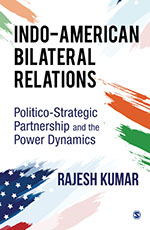Rajesh Kumar seeks to cover the broad canvas of India’s most important bilateral relationship i.e., with the US, in this book which examines the politico-strategic relations between the two countries from the early years of India’s Independence to the present.
The author starts off by studying the period between 1947-1984 and examines how relations between New Delhi and Washington evolved during this period. However, by way of introduction, the author gives definitions of foreign policy, national interest, etc., which might be of little interest to erudite readers though it would be useful to students. The first chapter, ‘The Historical Background (1947-1984)’ takes us through relations between the two countries during the Cold War chronologically, focusing in particular on the US position on Kashmir, its military alliance with Pakistan and the help extended to India during the Indo-China War in 1962. In ‘Politico-Security Dynamics from 1985: A New Beginning’, the author examines the divergence between the two countries on India’s internal security issues like the Khalistan movement. The author gives credit to Rajiv Gandhi for reaching out to the US in 1985. He points out that by the latter half of the 1980s, the US wanted India to play a more effective role in South Asia as reflected in its support for Indian actions in Sri Lanka and the Maldives (pp. 58-59). The chapter on ‘Nuclear Cooperation: Past and Present’ traces how the US position on India’s nuclear programme changed from hostility during the Cold War to the civil nuclear agreement in 2005, which ‘legitimised India as a responsible state with advanced nuclear technology’ (p. 114).

